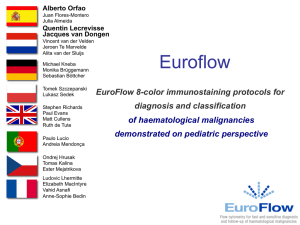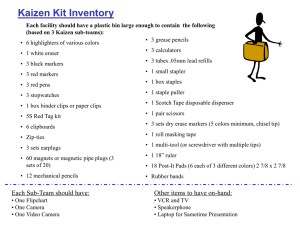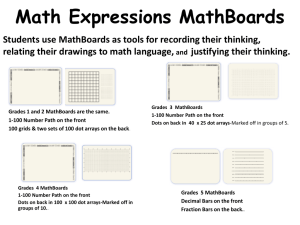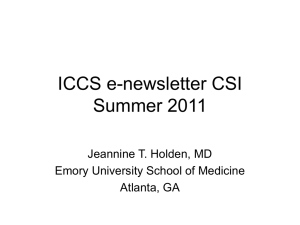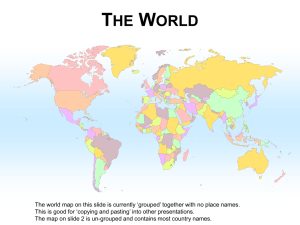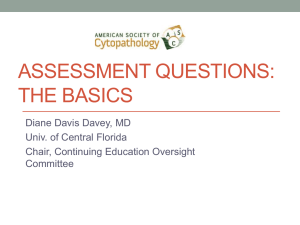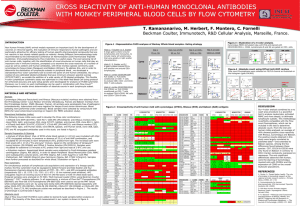Flow cytometry - Tata Memorial Centre
advertisement
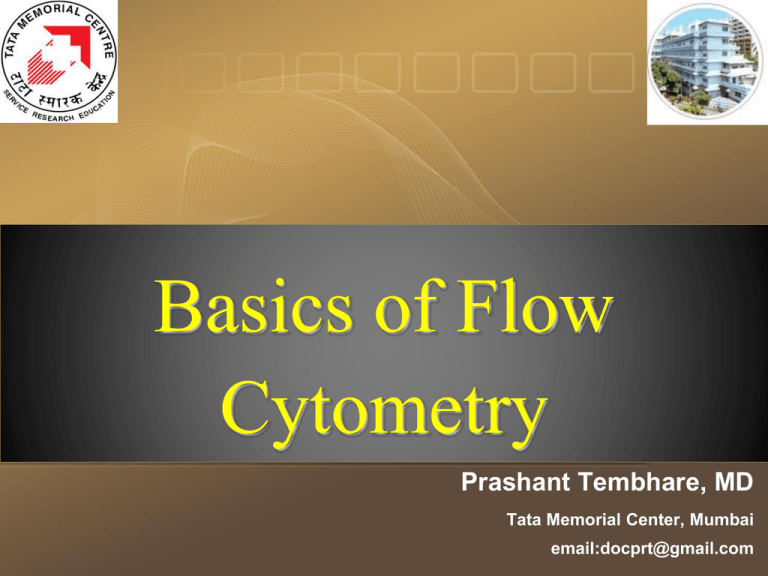
Basics of Flow Cytometry Prashant Tembhare, MD Tata Memorial Center, Mumbai email:docprt@gmail.com What is Flow Cytometry? Cyto = cells Metry = Measurement Flow = in a flow or a stream Page 2 Flow cytometry Flow cytometer is an instrument that - illuminates cells as they flow in front of a light source - detects and correlates the signals from illumination. Unique Ability – rapid analysis of thousands of cells Analyze 500-5000 cells/second - simultaneous illustration of multiple antigens Two major principles 1. Measurement of physical properties Page 3 2. Measurement of antigenic properties Page 4 Principles of flow cytometry 1. Measurement of physical properties i.e. size and complexity (granularity). Right Angle Light Detector c LASER BEAM Page 5 Forward Light Detector Principles of flow cytometry 2. Measurement of ANTIGENIC properties of cell surface and inside the cell with the help of antibodies labeled with different fluorochromes. c LASER BEAM Page 6 Instrument Components 1. Fluidics: Specimen, Sheath fluid, flow chamber. 2. Optics: Light source(s), mirrors, filters, detectors, spectral separation 3. Electronics: Controls pulse collection, pulse analysis, triggering, time delay, data display, gating, sort control, light and detector control 4. Data Analysis: SOFTWARE - Data display & analysis, multivariate/simultaneous solutions, identification of sort populations, quantitation Page 7 Page 8 Fluidics Crosland-Taylor - Hydrodynamic focussing = coaxial flow → a narrow stream of cells flowing in a core within a wider sheath stream • Provides a highly controlled fluid stream. • Provides exact location of a cell in three dimensions • Maintains sample handling compartment (Flow Cell) • Forced under pressure through a conical nozzle assembly geometrically designed to produce a laminar flow • This fluid is SHEATH FLUID - Isotonic fluid Page 9 Fluidics ↓D by 10-40 = ↑V by 100-1600 fold Page 10 HYDRODYNAMIC FOCUSING Page 11 2. OPTICS (a) LASER (argon) (b) Dichroic Filters and Mirrors (b) Photodiode (d) PMT (photo multiplier tubes ) Page 12 What is Fluorescence ? = 488 nm O HO = 520 nm C Incident Light Energy CO2H Fluorescein Molecule Antibody Emitted Fluorescent Light Energy The fluorochrome absorbs energy from the laser. • The fluorochrome releases the absorbed energy by: vibration and heat dissipation. Page 13 emission of photons of a longer wavelength. Mechanism of fluorochrome Page 14 Excitation & Emission Page 15 Fluorescence Emitted fluorescence intensity is proportional to binding sites FITC FITC FITC Number of Events FITC FITC Page 16 FITC FITC 0 FITC Log scale of Fluorescent Intensity FITC FITC Emission Spectra 100% PE APC PerCP Normalized Intensity FITC 0% 400 Page 17 500 600 Wavelength (nm) 700 800 Emission Spectra Cascade Blue FITC Alexa 430 PE PI APC PerCP PerCP-Cy5.5 PE-Cy7 Normalized Intensity 100% 0% 400 Page 18 500 600 Wavelength (nm) 700 800 Fluorescent Light Filteration Control Absorption No blue/green light red filter Page 19 Filters Page 20 Dichroic Filters Can be a long pass or short pass filter Filter is placed at a 45º angle to the incident light Part of the light is reflected at 90º to the incident light, and part of the light is transmitted and continues on. Detector 1 Detector 2 Page 21 Dichroic Filter PMT – Photomultiplier Tubes Page 22 Coulter optical system - Elite PMT4 PMT2 PMT3 PMT1 555 - 595 575 BP 525 BP 488 BP 655 - 695 L L D 5 2 5 6 5 0 L D 0 9 4 APC The Elite optical system uses 5 side window PMTs and a number of filter slots into which any filter can be inserted PMT6 TM PMT7 Purdue Cytometry Labs Page 23 D 488 BK 632 BP 675 BP PMT5 BD optical system – Canto-II Page 24 Page 25 Optical Design Page 26 Electronics Page 27 Compute pulse height Perform calculations for pulse area and pulse width Calculate ratios Convert analog signals to proportional digital signals Interface with the computer for data transfer Laser Voltage Electronics: Triggering on a voltage pulse Laser Voltage Time Laser Page 28 Voltage Time Time Optical to Digital PMT Voltage Signal Out Log amplification of signals 2 Options for SSC and fluorescence channels Photon In Analog to Digital Converter Linear amplification of signals Voltage In PMT Power Supply Levels 0–1000V adjusted by slider control on computer Page 29 compensation circuit Gain levels from 0–9.99 adjusted by slider control on computer Amplifier output voltage ranging between 10mV to 10V Optical to Digital Page 30 Data Analysis by Software Display Plots Create Gates Display Statistics Analyze Statistics Plot Types: Gate Types: Statistics Types: Results: Histogram Polygon # of Events % positive for Dot Ellipse % of Gated particular markers: Contour Histogram % of Total Density Quadrant Page 31 -viable cells -immunophenotype mean mean fluorescence intensity geometric mean DNA content standard deviation absolute counts Sample processing Single cell suspension: all specimens with cells in suspension PB, BMA, CSF, PF, BAL Solid tissue » Fine needle aspirations » Tissue suspensions - slicing, mincing and teasing = Filtering Sample stabilization: Anticoagulant - EDTA or Heparin Enrichment of cells: For leucocytes - RBC Lysis - NH4CL or - Density gradient centrifugation – Ficoll medium Antibody staining: Separate cells-wash-incubate with Ab-F in dark Acquisition: Acquire the stained cells at earliest or Fixed and store in refrigerator Data Analysis: Page 32 VIMP – Needs experience and knowledge Common Clinical Applications Enumeration of lymphocyte subsets (CD4/CD8) Immunophenotyping of hematologic malignancies Minimal Residual Disease (MRD) Myelodysplatic Syndrome (MDS) HLA B27 typing PNH diagnosis (CD55-/CD59-) DNA/RNA analysis & Cell cycle studies Reticulocyte analysis Hemotopoietic stem cell (CD34+)analysis Platelet analysis Antigen quantitation e.g. CD20, CD22, CD33 etc Other uncommon Microbiology Determination of drug resistance to chemotherapy Page 33 Cell Function analysis Analysis Approach Page 34 Management of Leukemia Accurate diagnosis and classification Knowledge of prognostic factors Monitoring response Diagnosis of early relapse at other sites like CNS Page 35 ALL naïve B-lymphocytes AUL Lymphoid progenitor Plasma cells T-lymphocytes Mixed Lineage Leukemia AML Hematopoietic stem cell Myeloid progenitor Neutrophils Eosinophils Basophils Monocytes Platelets Red cells Page 36 FCM in diagnosis and classification Identification of blasts Enumeration of blasts Assignment of blast lineage Identification of abnormal blasts Subclassification Page 37 Identification of blasts Low side light scatter Weak CD45 expression Markers of immaturity such as CD34 and TdT 10 196608 SSC-A 84.98% 3 cyTdT-FITC 4 10 0.00% 262144 2 131072 10 65536 1 10 Lack markers of maturation 00 B lymphoblasts – surface light chains 10 CD34 PerCP T lymphoblasts – Surface CD3 15.02% 5 10 0 10 1 10 10 210 3 4 10 10 CD4510PerCP10 10 CD45-ECD Myeloblasts - CD11b, CD15, CD16. kappa/lambda 0.00% 10 10 10 2 3 4 4 3 2 1 0 10 0 10 10 1 10 2 10 CD45 FITC Page 38 3 10 4 Enumeration of Blasts Flow cytometric count lower than manual count Dilution with peripheral blood Some blasts lack expression of CD34 and CD117 CD45 expression may very Flow cytometric count higher than manual count Loss of NRBCS during red cell lysis. Ficoll Hypaque separation Blast identifications may be difficult due to poor preservation or may be disrupted during smear preparation Page 39 Immunophenotypic markers Markers of Immaturity – TdT, CD34 Lineage Specific markers Myeloid - cMPO B cell - cCD22/cCD79a T cell - cCD3 Lineage Associated markers Myeloid - Common - CD13, CD33, CD117 - Other - CD11b, CD15 Monocytic - CD13, CD33, CD64, CD68, CD117, CD11b, CD14, CD4, cLysozyme Erythroid - CD36, CD71, CD105, CD235a (Glycophorin A), Hb Megakaryocytic - CD36, CD41, CD42, CD61 andCD62 B cell - CD19, CD22, CD20, cCD79a, CD10, cIgM, sIg T cell - Common - CD1a, CD2, CD5, CD7, CD10 - Other - CD4, CD8, CD3, NK cell - CD16, CD56, CD57, CD94, KIR PDC - CD123, CD4, CD56, CD68, CD33, CD43, BDCA, Page 40 - Other on PB subset CD2, CD5, CD7 Lineage Infidelity markers (Leukemia associated immunophenotype; LAIP) Lymphoid markers in AML - CD7, CD56, CD2, CD5 and CD19. Myeloid markers in ALL – CD13, CD33, CD117, CD15 Other Markers useful for MRD detection Associated with AML – CD38, CD45, CD68, HLADR Associated with ALL – CD9, CD24, CD25, CD52, CD58, CD81, CD123 Page 41 AML M0 Page 42 AML M2 t(8;21)(q22;q22) RUNX1-RUNX1T1 Page 43 AML M5a Page 44 AML Monocytic differentiation (M5b) Page 45 AML M6 Page 46 AML M7 Page 47 B - ALL Page 48 T - ALL Page 49 Borowitz M, Bene M, Harris N and Matutes E, (2008) Acute leukaemias of ambiguous lineage., Page Health 50 World Organization Classification of Tumours IARC Press, Lyon, pp. 150–155. Page 51 EG Weir and MJ Borowitz. Leukemia (2007) 21, 2264–2270. Page 52 Bi-lineal Leukemia Antigens Early (St-1) Intermediate (st 2 & 3) Mature B cells TdT + - - CD34 + - - CD10 bright dim - CD19 dim intermediate bright CD22 dim dim intermediate CD20 - (-/+) weak intermediate CD38 bright bright variable CD45 dim intermediate bright CD58 dim dim dim CD81 bright bright intermediate Cyt IgM - + + K/L - -/+ + Page 53 ALL in various cluster patterns Page 54 Role of flow cytometry in CLPD & MM Diagnosis Staging of lymphoma – Bone marrow involvement or body fluids Prognostication eg Zap 70 in CLL Minimal residual disease Diagnosis of relapse Page 55 Analysis Approach I. Isolation of cells using lineage specific markers like CD19 for B cells and CD3 for T cells II. detection of abnormal immunophenotype III. Clonality evaluation eg kappa or lambda IV. Note size of cells – FSC Page 56 Antibody panels- B CLPD Mature B cells CD19, CD20, CD22, cyto79a, CD79b Mature T cells CD2, CD3, CD4, CD5, CD7, CD8, TCR αβ/γδ NK cells CD2, cytoCD3, CD7, vCD8, CD16, CD56, vCD57, CD94, CD158 (KIRs) Plasma cells CD138, bCD38, CD19, cyto79a, cyto-Kappa, cyto-Lambda Clonality markers – B cells - sKappa, sLambda, – PCs - cyto-Kappa, cyto-Lambda – T cells – TCR V beta repertoire Other important Markers CD45, CD38, HLADR, Granzyme, Perforin, TIA Page 57 Disease oriented B CLPD – CLL – CD19,CD5, CD23, d-n CD20, d-n CD22, d-n FMC7, CD43, CD81, CD200 – HCL – CD11c, CD25, CD103, CD123 – FCL/DLBCL – CD10 – MCL – CD5 & CCD MM – CD19, CD20, CD27, CD45, CD56, CD81, CD117 T CLPD – ATLL/CTCL – CD25, CD26, CD27 – AILT – CD10 – ALCL – CD30 – EATCL – CD103 Page 58 Approach to immunophenotyping CLPD Identification of lineage: expression of lineage specific markers. B cell lineage- CD 19 or CD20 (CD20 may be lost after treatment with rituximab). Immunoglobulin Light chain restriction T cell lineage- CD7, CD3, CD2, CD5 (many markers may be lost in null cell phenotype) TCR V beta repertoire restricted usage NK cell – CD7, cytoCD3, CD2, CD16, CD56, CD57 Page 59 Page 60 CLL MANTLE CELL LYMPHOMA Page 61 Page 62 HAIRY CELL LEUKEMIA Page 63 ATLL PERIPHERAL T CELL LYMPHOMA - NOS Page 64 Immunophenotype of plasma cells Normal plasma cells Specific markers- CD138, CD38 (strong) B cell lineage – weak CD19, strong CD27 Moderate expression of CD45 Neoplastic plasma cells Aberrant expression- CD20, bCD56, CD28, CD117, CD200 Loss of CD19, CD27, CD45, CD81 Surface/Cytoplasmic light chain restriction Page 65 Multiple Myeloma 0.15% 8c icPC 38v450+ 19+45+ 5 1.20% 5 10.83% 10 10 CD56 PC7 CD19 APC 32.66% 4 10 3 CD19 neg PCs 10 4 10 3 10 9.63% 2 10 2 10 78.34% 67.02% 2 10 3 4 2 10 5 10 10 CD45 V500 10 3 4 10 10 CD19 APC 5 10 0.18% Br CD81+ 3 10 2 10 10 3 10 Dim CD81+ 2 Page 66 3 4 5 10 10 10 CD19 PerCP Cy55 4 3 10 2 10 2 10 63.90% 3 4 10 10 8c icKappa PE 12.39% 20.49% 10 2 10 3.05% 10 5 10 4 CD19 APC 4 10 20.32% 5 12.73% 10 CD19 APC 5 10 5 10 63.35% 3.76% 2 10 3 4 5 10 10 10 8c icLambda FITC Page 67 THANK YOU! Page 68

